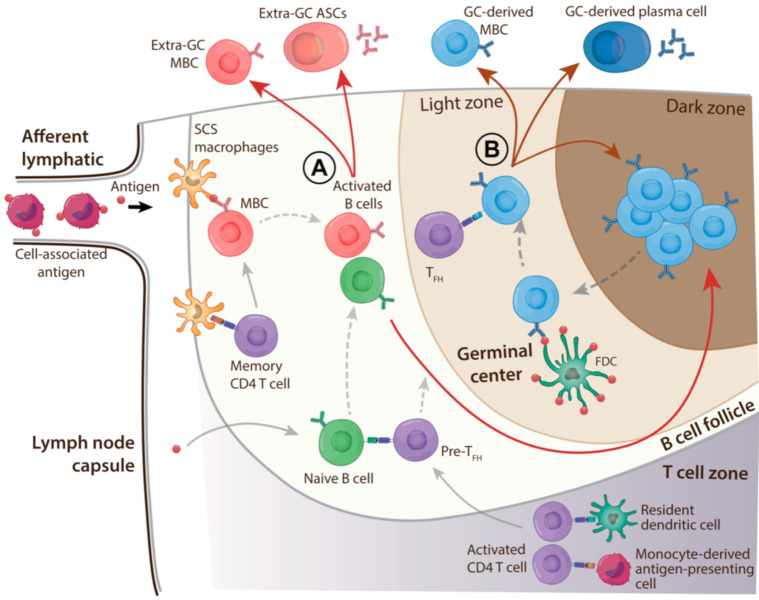Figure 2.
Overview of the HA-specific B cell response in a draining lymph node after administration of vaccine with squalene-based emulsion (SE) adjuvant. SE adjuvants promote antigen transport to lymph nodes by monocyte-derived cells. These cells, which cross sinus linings to enter lymph node parenchyma, have the potential to deliver intact antigen and also to serve as highly efficient antigen-presenting cells for CD4 T cell activation. Free lymph-borne antigen enters lymph node parenchyma via multiple routes such as trapping by subcapsular sinus macrophages and transfer for memory CD4 T cell activation or recognition by memory B cells (MBCs) and naïve B cells. Direct antigen transfer across lymphatic endothelial cells into lymph nodes also occurs. Abundant antigen availability in draining lymph nodes after administration with SE adjuvants diminishes B cell competition (for example, between MBCs and naïve B cells) for cognate antigen required for activation. MBCs and naïve B cells that “see” cognate antigen receive T cell help to drive activation and proliferation. Pathway options for activated B cells (A, red arrows) include (i) formation of extrafollicular antibody-secreting cells (ASCs); (ii) formation of extrafollicular MBCs; and (iii) entry into germinal center (GC) reactions. After maturation of immunoglobulin V region genes in GCs, GC B cells “test” their receptor affinity by competing for antigen held by follicular dendritic cells (FDCs). Successful acquisition of antigen from FDCs enables GC B cells to be stimulated by T cells and to repeat the maturation/selection cycle or differentiate into MBCs or antibody-secreting plasma cells and exit the GC (B, dark red arrows). The abundant free antigen in the lymph node is shuttled to FDCs, reducing the stringency of GC B cell selection after somatic mutation. In addition, strong CD4 T cell activation and formation of T follicular helper (TFH) cells promoted by SE adjuvants increases the availability of help for GC B cells and facilitates selection. Overall, SE adjuvants enhance the activation and affinity maturation of naïve B cells.

